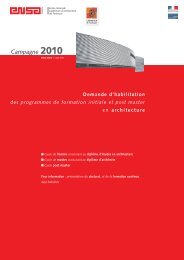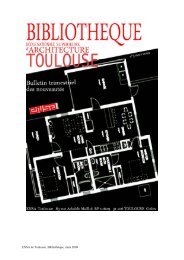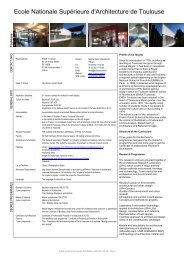johannesburg mumbai - Ecole nationale supérieure d'architecture ...
johannesburg mumbai - Ecole nationale supérieure d'architecture ...
johannesburg mumbai - Ecole nationale supérieure d'architecture ...
You also want an ePaper? Increase the reach of your titles
YUMPU automatically turns print PDFs into web optimized ePapers that Google loves.
67<br />
Engagements<br />
Commitment<br />
<strong>johannesburg</strong><br />
<strong>mumbai</strong><br />
Toutes deux dans le top 30 des métropoles<br />
qui comptent, Johannesburg<br />
(Afrique du Sud, 10 millions d’habitants)<br />
et Mumbai (Inde, 21 millions<br />
d’habitants) sont toutes deux<br />
confrontées à des situations de précarité<br />
urbaine pour des raisons et dans<br />
des proportions différentes. Retour<br />
sur deux expériences visant à améliorer<br />
le sort de populations en demande<br />
d’un droit au logement et à la ville.<br />
Pour un droit<br />
à la ville<br />
For a right<br />
to the city<br />
Both are in the top 30 of the world’s<br />
major metropolises, Johannesburg<br />
(South Africa, 10 millions inhabitants)<br />
and Mumbai (India, 21 million<br />
inhabitants) are also both confronted<br />
by urban poverty, for different reasons<br />
and in different proportions.<br />
A report on two experiments aiming<br />
to improve the conditions of a part of<br />
the population who demand a right<br />
to the city and decent lodging.<br />
Engagements : Parce que la société civile et les ONG sont aussi des acteurs essentiels de la transformation de la ville et de la défense de la qualité architecturale.<br />
Commitment: Because civilian society and NGOs are also essential players in the demand and fight for the right to urbanity and architectural quality.
<strong>johannesburg</strong>
La leçon<br />
de Hillbrow<br />
Le début de l’été a vibré au son des<br />
vuvuzelas et de la Coupe du monde de<br />
football, montrant une Johannesburg<br />
transfigurée par l’événement sportif<br />
international. Depuis la fin de l’apartheid,<br />
la métropole d’Afrique du Sud,<br />
véritable centre économique du pays,<br />
a beaucoup changé. Les populations<br />
aisées et principalement blanches ont<br />
migré vers la périphérie, tandis que<br />
certains des plus pauvres rejoignaient<br />
le centre-ville. Dans le quartier de<br />
Hillbrow, les immeubles abandonnés<br />
par leurs anciens propriétaires sont<br />
devenus des taudis. Aujourd’hui, des<br />
associations tentent de redonner une<br />
dignité à ce centre- ville et d’aider les<br />
populations à reconquérir un droit à<br />
la ville.<br />
The Lesson<br />
of Hillbrow<br />
The early summer vibrated to the<br />
sound of vuvuzelas and the Football<br />
World Cup, showing us a Johannesburg<br />
transfigured by this international sporting<br />
event. Since the end of apartheid,<br />
the South African metropolis, the real<br />
economic centre of the country, has<br />
changed greatly. The well-off populations,<br />
mostly white, have migrated to<br />
the city’s periphery, while some of the<br />
poorest inhabitants have moved to the<br />
city centre. In the Hillbrow neighbourhood,<br />
apartment buildings abandoned<br />
by their former owners have become<br />
slum dwellings. Today, associations<br />
are attempting to restore dignity to<br />
the city centre and help populations<br />
reconquer their right to the city.
« À Hillbrow, les immeubles<br />
jadis clinquants prennent<br />
les traits de bidonvilles verticaux. »<br />
Au soir du 3 juillet 2010, l’Espagne<br />
battait le Paraguay en quart de finale<br />
de la Coupe du monde de football à<br />
l’Ellis Park Stadium. Autour de cette<br />
enceinte sportive historique, qui a<br />
connu la victoire des Springboks<br />
lors de la Coupe du monde de rugby<br />
en 1995, quatre ans après la fin de<br />
l’apartheid, les stands des annonceurs<br />
et le media center étaient déjà<br />
en cours de démontage. Le Mondial<br />
terminé, la ville éphémère du football<br />
va maintenant attendre sa prochaine<br />
grand-messe pour s’installer ailleurs.<br />
Quant à la métropole sud-africaine,<br />
elle reprend son cours « normal ».<br />
Situé en plein centre-ville, à 20 minutes de<br />
marche du stade, le quartier de Hillbrow. Il<br />
n’est pourtant pas conseillé de s’y rendre<br />
à pied, car on fait volontiers à Hillbrow la<br />
réputation d’être l’un des endroits les plus<br />
dangereux de la ville. De centre résidentiel<br />
prestigieux il y a quelques années, ce<br />
quartier est devenu une zone d’extrême<br />
pauvreté. Les immeubles jadis clinquants<br />
prennent aujourd’hui les traits de bidonvilles<br />
verticaux.<br />
Frans Sebothoma, qui a quitté les townships<br />
pour venir s’y installer dès les années 1990,<br />
estime que « la Coupe du monde a été profitable.<br />
On y a refait les routes et réorganisé<br />
les transports. Il y a eu un effort pour remettre<br />
le centre-ville en état, réparer les immeubles,<br />
les repeindre ». À en croire cet homme<br />
de 44 ans, qui gère des immeubles pour le<br />
compte de coopératives de propriétaires, le<br />
quartier a « beaucoup changé et en bien »<br />
depuis plusieurs années. Parmi les initiatives<br />
lancées pour lui redonner une dignité, celle<br />
du workshop Eunic Studio, un accompagnement<br />
à la réhabilitation mis sur pied en 2008<br />
par l’architecte français Christophe Hutin.<br />
Hillbrow, Christophe Hutin connaît bien.<br />
En 1994, après avoir habité Soweto, le<br />
township de Johannesburg, c’est ici qu’il a<br />
séjourné. Il raconte cette période de sa vie<br />
et ce qu’il a appris de l’urbanisme de l’apartheid,<br />
de l’orga nisation de l’habitat informel<br />
des shacks 1 , et plus tard de la réalisation des<br />
« maisons RDP », issues du Reconstruction<br />
development program mis en place par l’ANC<br />
de Nelson Mandela, dans L’Enseignement de<br />
Soweto 2 , un livre écrit à quatre mains avec<br />
Patrice Goulet.<br />
À l’époque, les gens pensaient que la fin de<br />
l’apartheid allait marquer la fin de la ségrégation<br />
urbaine. Pas si simple… Une part de<br />
la population noire des ghettos a migré vers<br />
le centre de Johannesburg, et notamment à<br />
Hillbrow, pour se rapprocher des lieux de travail.<br />
« Ce quartier avait été le haut lieu de la<br />
vie culturelle, avec des hôtels de grand standing,<br />
des boîtes de nuit. Avec ses immeubles<br />
des années 1930 ou encore de l’époque<br />
1960-1970, Hillbrow avait développé une<br />
architecture de qualité. Mais la majorité de<br />
la popu lation blanche a préféré partir et les<br />
bâtiments ont été abandonnés par leurs propriétaires<br />
», explique Christophe Hutin.<br />
Les tours ont ensuite été squattées. En 1994,<br />
se souvient l’architecte, il y avait encore dans<br />
son immeuble « un concierge, et les ascenseurs<br />
fonctionnaient ». Mais les conditions de vie se<br />
sont vite détériorées dans ces édi fices surpeuplés<br />
qui n’ont très vite plus offert ni hygiène ni<br />
sécurité, et souvent, ni eau ni électricité. « En<br />
l’absence de propriétaire, qui allait réparer une<br />
vitre quand elle était brisée ou donner l’argent<br />
nécessaire pour repeindre », interroge le photographe<br />
sud-africain Guy Tillim. Familier du<br />
quartier (sa grand-mère y avait habité au temps<br />
de sa splendeur), il y est retourné en 2004 pour<br />
rendre compte de sa misère. Si le centre de<br />
Johannesburg est devenu le théâtre de violences<br />
et de trafics en tout genre, Guy Tillim rappelle<br />
aussi que « la plupart des gens voulaient<br />
simplement vivre dans un endroit tranquille ».<br />
1. Cabanes rudimentaires de Soweto<br />
souvent faites de bois et de tôles.<br />
2. L’Enseignement de Soweto – Construire librement,<br />
par Christophe Hutin et Patrice Goulet. Éditions Actes<br />
Sud, collection L’Impensé, juin 2009, 22 €.
71<br />
“At Hillbrow, the once-showy<br />
buildings have begun to look like<br />
so many vertical shanty towns.”<br />
1. Cabanes rudimentaires de Soweto<br />
souvent faites de bois et de tôles.<br />
2. L’Enseignement de Soweto – Construire librement,<br />
by Christophe Hutin and Patrice Goulet. Éditions Actes<br />
Sud, collection L’Impensé, June, 2009, 22 €.<br />
On the evening of 3, July 2010,<br />
Spain beat Paraguay in the quarterfinals<br />
of the Football World Cup at<br />
Ellis Park Stadium. Around the historic<br />
sports venue, which witnessed<br />
the Springboks’ victory in the Rugby<br />
World Cup in 1995, four years after<br />
the end of apartheid, the advertising<br />
displays and the media centre were<br />
already being struck. Now that the<br />
World Cup is over, football’s ephemeral<br />
city will wait for the next major<br />
event to set itself up somewhere<br />
else. And the South African metropolis<br />
will return to its “normal” way<br />
of life.<br />
Hillbrow is in the heart of the city, a<br />
20-minute walk from the stadium. But it’s<br />
not considered a good idea to go there<br />
on foot – Hillbrow has the reputation of<br />
being one of the most dangerous parts of<br />
the city. From a prestigious residential area<br />
a few years ago, the neighbourhood has<br />
become an area of extreme poverty. The<br />
once-showy buildings have begun to look<br />
like so many vertical shanty towns.<br />
Frans Sebothoma, who left the townships<br />
to live there in the 1990s, feels that “the<br />
World Cup was profitable. Roads were<br />
rebuilt and transportation was reorganized.<br />
An effort was made to refurbish the city<br />
centre, repair the buildings, repaint them.”<br />
According to the 44-year-old, who manages<br />
buildings for owners’ cooperatives,<br />
the area has “changed a lot, and for the<br />
better” in the last few years. Among the<br />
initiatives taken to restore its dignity is the<br />
Eunic Studio workshop, a program to aid<br />
rehabilitation launched in 2008 by French<br />
architect Christophe Hutin.<br />
Christophe Hutin knows Hillbrow well. In<br />
1994, after having lived in Soweto, the<br />
Johannesburg township, he spent time<br />
here. He tells about that period of his life<br />
and what he learned from urbanism under<br />
apartheid, from the informal organization of<br />
the shacks 1 , and later from the RDP houses<br />
that came out of the Reconstruction<br />
Development Program set up by Nelson<br />
Mandela’s ANC in L’Enseignement de<br />
Soweto 2 , a book he co-authored with<br />
Patrice Goulet.<br />
At the time, people thought that the end of<br />
apartheid would mean an end to urban segregation.<br />
It wasn’t that simple… Part of the<br />
black population of the ghettos migrated<br />
toward the centre of Johannesburg, and in<br />
particular to Hillbrow, to be closer to their<br />
jobs. “This area had been a centre of cultural<br />
life, with luxury hotels and nightclubs.<br />
With its buildings dating from the<br />
1930s and from the 1960s-1970s, Hillbrow<br />
had developed quality architecture. But the<br />
majority of the white population decided to<br />
leave and the buildings were abandoned by<br />
their owners,” Christophe Hutin explains.<br />
Then squatters moved into the towers. In<br />
1994, the architect recalls, his building still<br />
had “a concierge and elevators that worked”.<br />
But living conditions rapidly deteriorated in<br />
the overpopulated buildings where there<br />
was soon no hygiene or security, and often<br />
no water or electricity. “With no owner,<br />
who was going to replace a broken windowpane<br />
or provide the money for repainting”<br />
says South African photographer Guy<br />
Tillim. Tillim knows the neighbourhood<br />
(his grandmother had lived there during its<br />
glory days) and returned there in 2004 to<br />
document its impoverishment. While it is<br />
true that the centre of Johannesburg has<br />
become the scene of violence and trafficking<br />
of all kinds, Guy Tillim also points<br />
out that “most people just wanted to live<br />
in a quiet place.” Today, so that the renovation<br />
of the centre of Johannesburg<br />
isn’t restricted to luxury operations only
Expulsion par les Red Ants,<br />
surnom des membres de<br />
la Wozani Security, chargée<br />
d’évacuer les squatteurs.<br />
Eviction by the Red Ants,<br />
nickname given to Wozani<br />
Security members, in charge<br />
of evacuating “squatters”.<br />
Auret Street, Jeppestown.<br />
Mbulelo’s bar, lieu du commerce<br />
informel (fruits et légumes,<br />
sucreries, journaux et cigarettes)<br />
Mbuelo’s bar, the place of informal<br />
commerce (fruit and vegetables,<br />
sweets, newspapers and cigarettes)<br />
Joel Road, Berea.<br />
Milthred Court,<br />
Kerk Street.
73<br />
Le workshop de l’Eunic<br />
sur le toit de l’Huntly Hall.<br />
Eunic’s worshop on the<br />
roof of Huntly Hall.<br />
Depuis le toit<br />
du Harrison Reef.<br />
On the roof of the<br />
Harrison Reef.<br />
Thulisile, 8 e étage – 8 th floor,<br />
San Jose, Olivia Street, Berea.
« Maintenant que les habitants peuvent rester et obtenir<br />
des aides, c’est à nous de les aider à créer<br />
des conditions de vie décentes. »<br />
Christophe Hutin<br />
Aujourd’hui, pour que la rénovation du centre<br />
de Johannesburg ne se traduise pas uniquement<br />
par des opérations grand luxe et<br />
donc par l’exclusion de ses habitants les<br />
plus modestes, parmi lesquels de nombreux<br />
étrangers issus d’autres pays africains,<br />
diverses actions sont menées par les pouvoirs<br />
publics et des associations. Les avocats<br />
membres du Centre for Applied Legal<br />
Studies (CALS) ont ainsi œuvré pour faire<br />
reconnaître l’interdiction d’expulser les<br />
habitants sans proposition alternative. Des<br />
coopératives d’habitants « devenus propriétaires<br />
de leur immeuble avec l’aide du<br />
gouvernement » se sont formées, explique<br />
Frans Sebothoma.<br />
Harrison Reef.<br />
« Maintenant que des habitants peuvent rester<br />
et obtenir des aides, c’est à nous de les<br />
aider à créer des conditions de vie décen tes »,<br />
estime Christophe Hutin. L’architecte a donc<br />
mobilisé en 2009 l’Eunic Studio 3 et ses étudiants<br />
volontaires pour travailler sur l’amélioration<br />
des conditions de vie des habitants de<br />
deux immeubles d’Hillbrow : l’ancien hôtel<br />
Harrison Reef, à l’angle de Pretoria Street<br />
et de Twist Street ; et la résidence Huntly<br />
Hall, au croisement de Wolmarans et Banket.<br />
Les étudiants ont suivi Frans Sebothoma<br />
dans la visite des imm eubles et profité<br />
d’interventions de GuyTillim, de l’architecte<br />
sud-africaine Carin Smuts 4 , du Germano-<br />
Burkinabé Francis Kéré ou encore de Jean-<br />
Philippe Vassal, de Lacaton-Vassal, avant de<br />
livrer leurs cinq propositions.<br />
Datant des années 1960, « Harrison Reef<br />
était le plus bel hôtel de la ville, avec ses 103<br />
chambres et suites. Aujourd’hui, ce sont les<br />
appartements de 103 familles. Il faut donc<br />
faire évoluer la qualité de vie des 103 et<br />
pas une de moins », note Christophe Hutin.<br />
Les participants ont évoqué la création de<br />
cui sines partagées, la transformation des<br />
paliers en espaces de vie communs, la transformation<br />
d’une cour intérieure en jardin ou<br />
encore la possibilité d’augmenter le nombre<br />
de commerces en rez-de-chaussée, et donc<br />
les revenus des propriétaires. Des interventions<br />
simples, à la fois pragmatiques et sur<br />
mesures. Christophe Hutin ne prétend pas<br />
débouler avec la solution à tous les problèmes.<br />
« Je ne suis pas là pour faire la leçon.<br />
En Afrique du Sud, c’est plutôt moi qui ai<br />
appris que l’inverse. »<br />
Pour Iain Low, professeur à l’université<br />
d’archi tecture du Cap, également intervenant<br />
à l’Eunic Studio, le jeune architecte<br />
français est cependant en situation d’apporter<br />
beaucoup : « Il est très volontaire et puis<br />
il est un inside outsider. Il est étranger mais<br />
connaît bien notre pays. Il est en position<br />
d’être à la fois objectif et informé. » Iain<br />
Low aimerait que de tels exemples amènent<br />
les institutions à forger des projets à plus<br />
grande échelle mais aussi que, dans la foulée,<br />
l’enseignement de l’architecture dans<br />
le pays soit repensé. Frans Sebothoma est<br />
enchanté par l’expérience. Il aime dire que<br />
« l’Eunic Studio [l]’a aidé plus que toute autre<br />
chose ». Il est vrai que désormais, quand les<br />
représentants des coopératives de Huntly<br />
Hall ou de Harrison Reef devront aller négocier<br />
des prêts ou des aides auprès des banques<br />
ou des institutions gouvernementales<br />
et municipales, ils auront du concret à mettre<br />
sur la table.<br />
En novembre prochain, Christophe Hutin<br />
propose de faire plancher la troisième cession<br />
de l’EUNIC Studio à l’amélioration d’un<br />
ancien site hospitalier. Mais ça, c’est une<br />
autre histoire.<br />
Marie-Douce Albert<br />
Photos de Guy Tillim et Christophe Hutin<br />
3. Un workshop créé avec le soutien<br />
de l’European union national institutes for culture.<br />
4. À la tête de l’agence CS Studio, Carin Smuts,<br />
connue pour son engagement contre l’apartheid<br />
et l’amélioration des conditions de logement<br />
des plus démunis, a été la lauréate du Global Award<br />
for Sustainable Architecture 2008.
75<br />
“Now that the inhabitants can stay<br />
and obtain aid, it’s up to us to help them<br />
to create decent living conditions.”<br />
Christophe Hutin<br />
– thereby excluding its less affluent inhabitants,<br />
who include many immigrants from<br />
other African countries –, various actions<br />
are being taken by the authorities and by<br />
non-profit associations. The attorneys who<br />
are members of the Center for Applied<br />
Legal Studies (CALS) have worked to make<br />
it unlawful to evict anyone without proposing<br />
an alternative. Cooperatives of inhabitants<br />
“who have become owners of their<br />
buildings with the help of the government”<br />
have formed, Frans Sebothoma explains.<br />
“Now that the inhabitants can stay and<br />
obtain aid, it’s up to us to help them create<br />
decent living conditions,” says Christophe<br />
Hutin. In 2009, the architect mobilized Eunic<br />
Studio and its student volunteers to work<br />
on improving living conditions for inhabitants<br />
of two buildings in Hillbrow – the former<br />
Harrison Reef hotel, at the corner of<br />
Pretoria Street and Twist Street, and Huntly<br />
Hall, at Wolmarans and Banket. The students<br />
went with Frans Sebothoma to visit<br />
the buildings and hear presentations by Guy<br />
Tillim and architects Carin Smuts of South<br />
Africa, the German-Burkinabè Francis Kéré,<br />
and Jean-Philippe Vassal of Lacaton-Vassal<br />
before submitting their five proposals.<br />
living spaces, making an interior courtyard<br />
into a garden, and the possibility of<br />
increasing the number of businesses – and<br />
thus the owners’ revenues – on the ground<br />
floor. Simple proposals, pragmatic and tailored<br />
to the situation... Christophe Hutin<br />
doesn’t pretend to have a ready-made solution<br />
to all the problems. “I’m not here to<br />
give lessons. In South Africa, I’m the one<br />
who’s done a lot of the learning.”<br />
Yet Iain Low, a professor at the University<br />
of Cape Town architecture school who also<br />
works at Eunic Studio, feels that the young<br />
French architect has much to offer: “He’s<br />
very strong-willed, and he’s also an ‘inside<br />
outsider’ – he’s a foreigner, but he knows<br />
our country well. He’s in a position to be<br />
both objective and well informed.” Iain<br />
Low would like for examples like this one to<br />
encourage institutions to forge projects on<br />
a larger scale, but also for the teaching of<br />
architecture in the country to be re-thought<br />
in the process.<br />
Frans Sebothoma is delighted with the<br />
experience. He’s fond of saying that “Eunic<br />
Studio helped me more than anything else.”<br />
And it’s true that now, when representatives<br />
of the Huntly Hall or Harrison Reef<br />
cooperatives go to negotiate loans or aid<br />
with banks and government institutions,<br />
they’ll have something concrete to bring to<br />
the table.<br />
Next November, Christophe Hutin proposes<br />
that the third session of the Eunic Studio<br />
work on improving a former hospital site.<br />
But that’s another story.<br />
Huntly Hall.<br />
Marie-Douce Albert<br />
Photos by Guy Tillim and Christophe Hutin<br />
3. A workshop created with support from the<br />
European Union National Institutes for Culture.<br />
4. Head of the CS Studio agency, Carin Smuts,<br />
known for her commitment against apartheid and<br />
to improving housing conditions for the poorest<br />
citizens, won the 2008 Global Award<br />
for Sustainable Architecture.<br />
Dating from the 1960s, “Harrison Reef was<br />
the finest hotel in the city, with 103 rooms<br />
and suites. Now they serve as apartments<br />
for 103 families. The quality of life of all<br />
103 needs to be improved, and not a single<br />
one less,” says Christophe Hutin. The participants<br />
discussed the creation of shared<br />
kitchens, turning the landings into shared
MUMBAI
MUMBAI :<br />
du bidonville<br />
à la ville<br />
En Inde, entre 30 et 60 % de la population<br />
urbaine vit dans des bidonvilles.<br />
Mumbai, dont la population est passée<br />
de 8 à 21 millions entre 1981 et 2010,<br />
est particulièrement confrontée à cette<br />
problématique. L’ONG Sparc (Society<br />
for the Promotion of Area Resource<br />
Centers) aide des fédérations d’habitants<br />
précaires à faire valoir leurs droit<br />
à la ville. Sheela Patel, fondatrice et<br />
directrice de Sparc, expose quelques<br />
unes de ses actions.<br />
BOMBAY:<br />
from slum<br />
to city<br />
In India, between 30 and 60% of<br />
the urban population live in slums.<br />
Mumbai, whose population has gone<br />
from 8 to 21 million between 1981<br />
and 2010, is particularly affected by<br />
this phenomenon. The Sparc (Society<br />
for the Promotion of Area Resource<br />
Centers) NGO helps groups of precarious<br />
inhabitants to stand for their<br />
right to urban living. Sheela Patel,<br />
founder and director of Sparc, tells<br />
us here of some of their actions.
« Les villes vivent du travail bon<br />
marché de migrants sans ressources,<br />
mais peu leur font de la place. »<br />
Aux yeux de la communauté inter<strong>nationale</strong>,<br />
la trajectoire décrite par l’Inde<br />
au fil des 10 dernières années est celle<br />
d’un pays porté par une croissance<br />
économique phénoménale, auquel sourit<br />
tout un horizon d’opportunités. On<br />
passe plus volontiers sous silence un<br />
phénomène tout aussi galopant qui<br />
lui fait pendant : l’explosion des villes<br />
indiennes et leur paupérisation, dont<br />
témoignent les bidonvilles caractéristiques<br />
de la plupart des métropoles du<br />
pays. Le bond économique accompli<br />
par l’Inde ces dernières années est une<br />
réalité indéniable, mais faute de se hisser<br />
à la hauteur des défis posés par la<br />
rapide expansion de ses villes, le souscontinent<br />
peinera dans les années à<br />
venir à associer sa population aux fruits<br />
de cette croissance, par une élévation<br />
générale du niveau de vie.<br />
Mumbai, Delhi, Calcutta et les autres grandes villes<br />
indiennes ont connu un essor particulièrement<br />
rapide et se sont trouvées dans l’incapacité de se<br />
doter des infrastructures, logements et services<br />
nécessaires pour faire face à cet accroissement de<br />
population. La population de Mumbai est ainsi<br />
passée de 8 millions d’habitants en 1981 à 21 millions<br />
environ en 2010. Érigée sur un petit archipel<br />
formant une masse continentale aux abords d’un<br />
port naturel, la ville s’est étendue jusqu’à atteindre<br />
la taille d’une région métropolitaine englobant<br />
son arrière-pays et les six autres associations<br />
de communes, les treize municipalités et les<br />
nombreux villages. Mumbai couvre aujourd’hui<br />
4.355 km 2 et compte une population officielle de<br />
17.702.761 habitants (recensement de 2001) pour<br />
une densité de 4.065 habitants au km 2 .<br />
Comment l’Inde peut-elle poursuivre sa croissance<br />
économique tout en préparant ses vi lles<br />
à l’arrivée des 250 millions de personnes qui<br />
devraient quitter les zones rurales au cours des<br />
20 prochaines années Étant donné que 30 à<br />
60 % des citadins indiens vivent dans des bidonvilles<br />
et que la population urbaine devrait presque<br />
doubler d’ici à 2030, pour s’établir à 575 millions<br />
d’habitants, il devient impératif de trouver une<br />
solution durable et opérationnelle pour soulager<br />
la pression de plus en plus forte qui s’exerce sur<br />
les villes indiennes.<br />
Or ni l’administration, ni la classe politique ni le<br />
public n’ont pris la mesure de ces questions et un<br />
grand nombre continuent obstinément de penser<br />
l’Inde comme une terre constitué de millions<br />
de villages. Le mouvement d’urbanisation ne va<br />
pourtant ni s’interrompre ni, a fortiori, s’inverser.<br />
La population ne renoncera pas aux débouchés<br />
économiques de la ville et à ses libertés sociales<br />
pour retourner au marasme et à la misère<br />
des villages. Ce n’est d’ailleurs pas souhaitable :<br />
la croissance économique de l‘Inde est largement<br />
tributaire des migrations de main d’œuvre à destination<br />
des vi lles. L’urbanisation constitue une<br />
dimension intrinsèque du développement, capable<br />
en puissance d’améliorer le sort de millions<br />
de personnes, pour peu que la population prise<br />
dans cette dynamique y soit activement associée.<br />
L’ONG Sparc aide des millions de citadins démunis<br />
à affirmer leurs besoins et faire valoir leurs droits et<br />
le rôle essentiel qu’ils jouent dans l’essor des villes<br />
indiennes de demain. En 2005, le gouvernement<br />
indien a officiellement annoncé la création de la<br />
mission de rénovation urbaine Jawaharlal Nehru<br />
National Urban Renewal Mission (JNNURM),<br />
qui a pour objectif de financer des projets dans<br />
65 villes du pays, qui en contrepartie réaliseront<br />
des réformes indispensables leur permettant de<br />
mieux exercer leurs compétences.<br />
Panorama du logement<br />
et des infrastructures<br />
La rapide urbanisation attire des millions de personnes<br />
en ville mais la pénurie de logements<br />
abordables oblige les plus démunis à se fixer dans<br />
des endroits de fortune. Bien que les villes vivent<br />
du travail bon marché de migrants sans ressources,<br />
peu de municipalités font place à ces populations<br />
dans leurs plans d’urbanisme. Il est donc<br />
crucial que les groupements qui les représentent,<br />
les autorités municipales et les institutions<br />
financières travaillent de concert pour apporter<br />
des solutions durables et abordables à cette<br />
crise du logement. Sparc et deux instances représentatives<br />
des populations, NSDF (National Slum<br />
Dwellers Federation) et Mahila Milan, ont formé<br />
une « Alliance » dont la stratégie vise à favoriser<br />
la constitution de fédérations, d’abord à Mumbai<br />
puis dans d’autres villes, au sein desquelles sont<br />
mutualisées les compétences et les ressources des<br />
populations démunies, pour leur permettre de<br />
lutter contre les expulsions et d’entamer un dialogue<br />
avec les autorités, dans le but d’améliorer la<br />
sécurité du territoire et les conditions de vie, ainsi<br />
que de faire reconnaître leur droit à la ville.<br />
La constitution de ces fédérations procède par<br />
regroupement progressif des occupants de<br />
divers terrains squattés. Cet article présente brièvement<br />
certains combats, négociations, actions<br />
et projets portés par cinq grandes fédérations<br />
affiliées à la NSDF, avec lesquelles l’Alliance travaille<br />
depuis plusieurs dizaines d’années à la<br />
recherche de solutions aux problèmes de logement<br />
des habitants des bidonvilles. À travers leur<br />
exemple, nous voulons démontrer qu’il est possible<br />
de réserver aux populations les plus démunies<br />
des villes un traitement plus équitable, pour<br />
peu qu’elles trouvent des champions au sein des<br />
pouvoirs publics, de la société civile et des communautés,<br />
qui se mobilisent pour elles.<br />
Voici quelques grandes fédérations de Mumbai,<br />
représentant les différentes catégories de<br />
bidonvilles :<br />
1. La Fédération des bidonvilles des trottoirs<br />
(Pavement Dwellers Federation) regroupe ceux<br />
qui ont érigé des appentis sur la voie publique.<br />
2. La Fédération des bidonvilles des voies ferrées<br />
(Railway Slum Dwellers federation) regroupe<br />
les bidonvilles constitués le long de voies ferrées<br />
actuellement exploitées.<br />
3. Dharavi Vikas Samittee : il s’agit d’un vaste<br />
bidonville informel né en dehors de la ville, qui en<br />
est devenu l’un des faubourgs en 1956 et s’étend<br />
aujourd’hui en plein cœur de Mumbai.<br />
4. Les bidonvilles du port de Mumbai.<br />
5. La fédération des bidonvilles de l’aéroport<br />
(Federation of Airport Slums) regroupant<br />
les logements de fortune érigés aux alentours de<br />
l’aéroport de Mumbai.<br />
La stratégie de ces fédérations obéit au principe<br />
suivant : tous les bidonvilles aux prises avec<br />
des difficultés de même ordre commencent par
79<br />
“The cities are fuelled by the cheap labour<br />
of poor migrants, but few authorities<br />
include them in their plan..<br />
To the international community, the<br />
Indian narrative of the past decade is<br />
one of phenomenal economic growth<br />
and a vast increase in opportunity.<br />
Less frequently noted is a correspondingly<br />
massive growth in India’s urban<br />
population and the vast increase in the<br />
numbers of urban poor, visible in the<br />
slums that characterize most Indian<br />
cities. The economic strides India has<br />
made in the past few years are real<br />
and significant, yet if India does not<br />
rise to the challenges presented by<br />
rapid urban growth, it will struggle to<br />
translate economic gain into improved<br />
quality of life for its people for years<br />
to come.<br />
India’s large cities – Mumbai, Delhi, Kolkata<br />
and the other metropolitan cities – have<br />
grown especially quickly, and have had been<br />
unable to provide infrastructure, housing and<br />
services to accommodate the growing population.<br />
Mumbai’s population, for example,<br />
has grown from 8 million in 1981 to approximately<br />
21 million in 2010. Starting from<br />
a small set of islands creating a land mass<br />
next to a natural harbour, the city has grown<br />
and has now become a metropolitan region<br />
absorbing its hinterland where there are six<br />
other municipal corporations and 13 municipal<br />
councils and many villages. It presently<br />
covers a land mass of 4,355 km sq. and has a<br />
official population of 17,702,761 (2001 census)<br />
and a density of 4,065 km sq.<br />
How can India continue to grow its economy<br />
while ensuring that its cities can accommodate<br />
the 250 million people expected to<br />
move to urban areas over the next 20 years<br />
With between 30 and 60 percent of urban<br />
Indians living in slums, and the urban population<br />
expected to nearly double to 575 million<br />
by 2030, finding a sustainable and functional<br />
solution to the growing pressure on Indian<br />
cities is imperative.<br />
Yet urban issues do not receive adequate<br />
attention from policymakers, politicians or<br />
the public, many of whom cling to the idea<br />
of India as a land of millions of villages.<br />
But urbanization will not stop, and it certainly<br />
will not reverse. People will not leave<br />
the economic opportunities and social freedoms<br />
offered by cities for a life of stagnant,<br />
wrenching poverty in rural villages.<br />
Nor should they: India’s economic growth is<br />
largely dependent on the migration of labour<br />
to jobs in cities. Urbanization is an inevitable<br />
part of development, and one that has<br />
the potential to change millions of people’s<br />
lives for the better. Yet for this positive<br />
change to occur, the people whose lives are<br />
being affected must be a part of the process.<br />
SPARC is committed to supporting the urban<br />
poor as they seek to assert their needs, their<br />
rights and their essential place in India’s<br />
vibrant urban future. In 2005, the Indian<br />
government formally announced the creation<br />
of the Jawaharlal Nehru National Urban<br />
Renewal Mission (JNNURM), which seeks to<br />
make major investments in the country’s 65<br />
cities and in return seeks urgently needed<br />
reforms that will equip cities to manage their<br />
roles and responsibilities better.<br />
Housing<br />
and Infrastructure Overview<br />
Rapid urbanization draws millions to urban<br />
areas, but the inadequate supply of affordable<br />
housing forces the poor to create homes<br />
wherever they can find land. Though cities<br />
are fuelled by the cheap labour of poor<br />
migrants, few authorities include the poor<br />
in development plans. It is therefore critical<br />
for organizations of the poor, city authorities<br />
and financial institutions to work in partnership<br />
to create sustainable and affordable<br />
solutions to this housing crisis. SPARC NSDF<br />
and Mahila Milan are an alliance of an NGO<br />
and two people’s organizations that have<br />
sought to develop a strategy by which, initially<br />
in Mumbai and subsequently in other<br />
cities in India, the urban poor form federations<br />
that build their skills and capacities to<br />
first resist evictions and subsequently begin<br />
to dialogue with cities and governments for<br />
improved land security, better amenities and<br />
the right to the city.<br />
The process of forming federations is based<br />
on aggregating those who squat on a particular<br />
landowner’s property. In this article,<br />
we briefly share with you some of the<br />
struggles, negotiations, policies and actual<br />
projects with five significant federations affiliated<br />
with the National Slum Dwellers federations<br />
with whom the alliance has worked<br />
over decades to find solutions to slum dwellers’<br />
habitat problems. Through this, we seek<br />
to demonstrate that equity for the most vulnerable<br />
in the city can be designed and can<br />
become a reality if the process of improving<br />
their lot has champions and leadership in the<br />
government, civil society and communities<br />
who seek change that works for the city and<br />
for the poor.<br />
Some of the most significant federations in<br />
Mumbai representing the various types of<br />
slums dwellers are:<br />
1. The Pavement Dwellers federations:<br />
these are households that build lean-tos on<br />
pavements.<br />
2. The Railway Slum Dwellers federations:<br />
these are slums that are near the railway<br />
tracks of operating trains.<br />
3. Dharavi Vikas Samittee: this is a large informal<br />
township that was outside the city till<br />
1956 and is now in the middle of the city,<br />
which has engulfed it.<br />
4. Slums on Mumbai Port land.<br />
5. Federations of Airport Slums: these are<br />
slums that surround the Mumbai airport.<br />
The general principles of the strategy are<br />
that all the slums facing a similar problem<br />
first form a federation and that their leadership<br />
work with the alliance to create a data<br />
base through which vital information about<br />
that group is produced by the communities.<br />
Through dialogue with the landowner, this<br />
data base is then accepted by the landowner,<br />
the city and the state government, which in<br />
a federal system manage urbanization and<br />
cities. Most often, the government does not
Les habitants des Pavement<br />
Dwellers, qui vivent à même le sol.<br />
The inhabitants of Pavement<br />
Dwellers, who live on the ground.<br />
Habitat des Railway Slums<br />
bidonville de Dharavi.<br />
The Railway Slums site,<br />
a slum in Dharavi.<br />
Enfants jouant dans<br />
les décombres des bidonvilles<br />
détruit par le gouvernement.<br />
Children playing in the rubble of slums<br />
destroyed by the government.
81<br />
Medha Pathkar prend<br />
la parole au cours d’une manifestation<br />
contre les démolitions des bidonvilles<br />
à Mumbai, le 6 avril 2005.<br />
Medha Pathkar, speaks during<br />
a protest against the demolition<br />
of slums, in Mumbai, April 6, 2005.<br />
Nouvelle construction à Bharat Janta,<br />
dans le bidonville de Dharavi.<br />
New housing in Bharat Janta,<br />
in the Dharavi slum.
« En 1995, le programme de réhabilitation<br />
des bidonvilles a reconnu aux populations<br />
le droit d’être relogées. »<br />
se regrouper en fédération, leurs responsables<br />
rejoignent l’Alliance pour créer une base de données<br />
dans laquelle des informations essentielles<br />
concernant ce groupe sont introduites par les<br />
communautés. Un dialogue se noue, qui permet<br />
de faire accepter la base de données aux propriétaires<br />
des terrains occupés, à la ville et aux autorités<br />
de l’État fédéral, lequel a compétence pour<br />
traiter des questions touchant l’urbanisation et la<br />
ville. La plupart du temps, ces autorités ne disposent<br />
pas de données sur la pauvreté et font<br />
ainsi fausse route dans leur recherche de solution.<br />
Les responsables des différents bidonvilles<br />
engagent une série d’échanges qui donnent lieu<br />
à un processus d’apprentissage officieux mais<br />
efficace, grâce auquel, dans un premier temps,<br />
les communautés impliquent les femmes dans<br />
l’instauration de programmes d’économies. De<br />
petits détails vitaux pour la délivrance de papiers<br />
d’identité sont facilités et permettent aux pouvoirs<br />
municipaux comme aux habitants de prendre<br />
conscience de l’importance de ces papiers,<br />
dans des cités où nombre d’occupants des<br />
bidonvilles sont sans identité officielle. Des solutions<br />
sont débattues dans le cadre de réunions<br />
et d’ateliers. Il ne saurait être question, dans le<br />
cas de bidonvilles installés sur la voie publique<br />
et le long des voies ferrées, de revendiquer un<br />
droit à occuper des lieux déjà affectés à un usage<br />
public. Ces groupes sont néanmoins sous le coup<br />
d’expul sions massives et n’étaient fondés à recevoir<br />
aucun dédommagement jusqu’en 1995, date<br />
où les autorités de Maharashtra (avec lesquelles<br />
nous travaillions alors depuis 10 ans) ont créé la<br />
Slum Rehabilitation Policy, programme de réhabilitation<br />
des bidonvilles qui a reconnu aux populations<br />
concernées la possibilité d’être relogées.<br />
Entre 2000 et 2007, plus de 16.000 ména ges<br />
(sur les 80.000 établis le long des voies ferrées)<br />
installés à l’intérieur de la bande de sécurité de<br />
9 mètres, ont accepté d’être relogés dans le<br />
cadre d’un vaste projet baptisé Mutpii (Mumbai<br />
Urban Transport Project) : les ménages ayant<br />
accepté d’être déplacés ont reçu en contrepartie<br />
un appartement de 21 m 2 .<br />
Depuis 2005, environ 10.000 foyers des bidonvilles<br />
sur la voie publique (sur plus de 28.000<br />
ménages concernés) ont eux aussi été relogés<br />
en appartements, après l’adoption de mesures<br />
municipales visant à organiser leur transfert,<br />
dans le cadre du Mumbai Urban Infrastructure<br />
Project (MIUP). Un processus toujours en cours.<br />
Dans les deux cas, le relogement pose d’abord<br />
des problèmes incontestables – allongement des<br />
temps de trajet et, dans beaucoup de cas, pertes<br />
d’emplois – mais étant donné l’expansion de<br />
la région métropolitaine de Mumbay (MMR) et le<br />
développement du réseau de transports reliant la<br />
ville à cette région, les ménages concernés auront<br />
de nouveau accès de plein droit au centre- ville.<br />
Les fédérations offrent assistance aux populations<br />
aux prises avec ces difficultés.<br />
La question des bidonvilles installés aux abords<br />
du Port de Mumbai et de l’aéroport national<br />
réclame la mise en place d’un dialogue avec les<br />
ministères centraux, les terrains occupés étant la<br />
propriété de l’État fédéral, qui n’a que des compétences<br />
limitées pour négocier ces questions.<br />
BPT est le principal organisme public possédant<br />
des terrains à Mumbai. Plusieurs projets pilotes<br />
sont à l’étude pour permettre aux fédérations de<br />
reloger les ménages sur des terrains destinés à<br />
être aménagés. De tous les chantiers ouverts par<br />
les fédérations, c’est toutefois le moins avancé.<br />
Les bidonvilles des terrains de la société aéroportuaire<br />
National Authority of India, qui entourent<br />
l’aéroport de Mumbai, continuent de poser<br />
une série de problèmes. On dénombre plus de<br />
100.000 abris de fortune. Nombre des habitants<br />
ou des entreprises qui y sont établis vivent<br />
de l’activité de l’aéroport et, depuis sa privatisation,<br />
de nombreux litiges restent en suspens.<br />
La fédération ne rencontre pas de problèmes<br />
avec les ménages à reloger, les terrains occupés<br />
devant être affectés aux activités de l’aéroport.<br />
Les populations exigent néanmoins des pouvoirs<br />
publics qu’ils leur soumettent les plans d’occupation<br />
des sols. Or en privatisant l’exploitation de<br />
l’aéroport, les pouvoirs publics ont également<br />
confié la construction des immeubles d’habitation<br />
à des promoteurs privés. Les justificatifs donnant<br />
droit aux ménages à être relogés ne leur ont<br />
toujours pas été délivrés et les pouvoirs publics<br />
ont également confié aux promoteurs l’ensemble<br />
des terrains restant à lotir, une fois pourvus<br />
les besoins de l’aéroport. Il y a là un point de<br />
b locage qui reste encore à lever.<br />
On dispose désormais d’une documentation fournie<br />
sur Dharavi. En 2004, l’État du Maharashtra<br />
a institué le Dharavi Redevelopment Authority.<br />
Dharavi constitue aujourd’hui une ville dans la<br />
ville au cœur de Mumbai. Les habitants y ont<br />
érigé logements et entreprises par leurs propres<br />
moyens. Après plusieurs tentatives de développement<br />
qui ont échoué à transformer la zone,<br />
la nouvelle stratégie consiste à associer le secteur<br />
privé, qui bénéficie d’incitations sous forme<br />
de projets immobiliers à forte plus-value situés<br />
dans la ville, en échange de la réhabilitation des<br />
bidonvilles. Ce projet, tout à fait séduisant sur le<br />
papier, pose en réalité de nombreux problèmes<br />
et fait l’objet de profondes réserves de la part<br />
de la population. Depuis 2004, une série de discussions<br />
sont en cours pour décider de l’orientation<br />
à prendre. Les citoyens, réunis en un comité<br />
d’experts conseillant le DRP, jugent dangereux<br />
de concevoir la rénovation de Dharavi comme<br />
un projet ex nihilo et les habitants ont subordonné<br />
leur accord à l’examen des plans d’aménagement<br />
prévus. Le projet de rénovation doit<br />
relever de nombreux défis : améliorer les conditions<br />
de vie de 600.000 personnes et leur permettre<br />
l’a ccès à un emploi décent. Or tout semble<br />
indiquer au contraire qu’un processus de gentrification<br />
conduira à leur expulsion.<br />
À bien des égards, Mumbai présente le visage<br />
d’une urbanisation mal encadrée et notre travail<br />
ainsi que les mesures générales prises par la ville<br />
et les États témoignent des difficultés issues du<br />
désengagement des pouvoirs centraux. Il est possible<br />
d’améliorer de façon significative les conditions<br />
de vie des populations concernées, mais<br />
plus on temporisera, plus les solutions seront<br />
douloureuses et plus le coût sera élevé pour la<br />
ville et la communauté. La plupart des indicateurs<br />
urbains montrent que les populations pauvres,<br />
sans terre et sans qualifications, qui migrent vers<br />
les zones métropolitaines sont en hausse et que<br />
la plupart des villes ne sont pas prêtes à un tel<br />
afflux. Mumbai, pourtant pourrait être la preuve<br />
que l’union et le dialogue peuvent faire émerger<br />
des solutions et ouvrir la voie au changement.<br />
SHEELA PATEL
83<br />
“In 1995, the Slum Rehabilitation Policy<br />
included the possibility of relocation<br />
for the population.”<br />
have data about the poor, and often starts<br />
off in the wrong direction to find solution.<br />
A series of exchanges between the leaders<br />
of various settlements facilitates an informal<br />
but well-articulated training process that first<br />
helps communities to involve women in starting<br />
savings programs. Small but vital aspects<br />
of creating their identity documentation are<br />
facilitated, which demonstrates to both the<br />
city and residents the importance of this documentation<br />
in cities where many slum dwellers<br />
have no official identity. Through ongoing<br />
meetings and workshops, the options for<br />
possible solutions are discussed. In the case<br />
of pavement dwellers and railway slums, it is<br />
clear that they cannot seek a solution for land<br />
entitlements where they live, as these entitlements<br />
conflict with public purpose. All these<br />
groups, however, faced massive evictions and<br />
were excluded from the compensation policy<br />
until 1995, when the Maharashtra government<br />
(we had been working with them<br />
for 10 years at this point) created the Slum<br />
Rehabilitation Policy, which finally included<br />
the possibility of relocation for them.<br />
Between 2000 and 2007, 16,000 + households<br />
(of the 80,000 who live on the land<br />
adjacent to railway tracks) along the railway<br />
tracks who were within the 9-meter safety<br />
zone agreed to be relocated as part of a large<br />
transport project called MUTPII (Mumbai<br />
Urban Transport Project) in which a relocation<br />
policy entitled them to a structure-for-structure<br />
replacement: they received a tenement<br />
of 21 square metres in exchange for agreeing<br />
to relocate.<br />
Since 2005, about 10,000 pavement dwellers<br />
(of the 28,000+ households) have been<br />
similarly relocated to tenements after the<br />
municipal corporation established a policy<br />
taking on the responsibility of relocating<br />
them under the aegis of the Mumbai Urban<br />
Infrastructure Project (MIUP), and this process<br />
is still underway.<br />
In both these instances, relocation definitely<br />
causes initial problems – longer travel time<br />
and in many instances loss of jobs – but given<br />
the expansion of the MMR region and new<br />
transport that will link the city to the metropolitan<br />
region, these households will once<br />
again be in the centre of the city with legal<br />
entitlements. The federations work hard to<br />
support and assist the vulnerable while they<br />
face these challenges.<br />
The slums on Mumbai Port land, like the<br />
slums on National Airport land, require dialogue<br />
with departments of the central government<br />
because the landowner is in fact the<br />
central government and the state has little<br />
authorization to negotiate on these issues.<br />
The BPT is the largest public agency that<br />
owns land in Mumbai. Some initial pilot projects<br />
are currently being explored in which the<br />
federations will seek to relocate households<br />
on a piece of land they want to create a project<br />
on, but unlike the other federations, this<br />
process is the farthest behind.<br />
The slums on National Authority of India land<br />
around the Mumbai airport still have many<br />
unresolved issues. There are over 100,000<br />
slum dwellings. Many of the residents and<br />
businesses are connected to the functioning<br />
of the airport, and since its privatization,<br />
they have been many unresolved and contentious<br />
issues to be tackled. The federation has<br />
no problems with households that need to<br />
be relocated because the land is needed for<br />
the functioning of the airport. However, they<br />
demand that the government show them the<br />
plans for the land’s use. The government,<br />
however, has privatized the management of<br />
the airport and has given the task of building<br />
tenements to a private developer. The documentation<br />
of households that will be entitled<br />
to relocation has still not been done, and the<br />
government has also given the company that<br />
is building the tenements all the additional<br />
land to develop after the airport‘s needs are<br />
met. This remains an unclear deadlock that<br />
has yet to be resolved.<br />
The Dharavi issues are now well documented.<br />
In 2004, the government of Maharashtra<br />
set up a Dharavi Redevelopment Authority.<br />
Dharavi is a consolidated township now in<br />
the centre of the city of Mumbai, with homes<br />
and businesses developed completely on their<br />
own by the residents. Since past attempts to<br />
develop Dharavi did not transform the area,<br />
the strategy of this new program was to bring<br />
in the private sector and give it incentives of<br />
high value real estate in the city in return for<br />
rehabilitating slum dwellings. This plan, while<br />
it sounds very sensible on a conceptual level,<br />
has many problems and the residents have<br />
deep reservations about it. Since 2004, there<br />
has been a series of ongoing discussions<br />
about how to proceed. Citizen groups, now<br />
invited as an expert committee to advise the<br />
DRP, believe that the risks of treating Dharavi<br />
as a green field project are dangerous, and<br />
residents have demanded to know what<br />
is being planned before any acceptance of<br />
the process. The redevelopment has to face<br />
many challenges: it has to take responsibility<br />
for ensuring that 600,000 lives improve and<br />
that the residents will get better jobs. Instead<br />
all the indications are that gentrification will<br />
di splace them.<br />
In many ways, Mumbai represents the face<br />
of badly managed urbanization and our work<br />
and the overall response of the city and state<br />
reflect the challenges that indifferent organizational<br />
processes in the government create.<br />
They can change and significantly improve<br />
the lives of households, yet the longer the<br />
delay the harder the solution and the higher<br />
the price both the city and community pays<br />
in human costs. Most urban indicators today<br />
show wthat cities will have more people who<br />
are poor, landless and without skills arriving<br />
in metropolitan areas, and most cities are<br />
unprepared to deal with them. But Mumbai<br />
can demonstrate that through alliance, negotiation<br />
and dialogue, there is a solution and<br />
that change is possible.<br />
SHEELA PATEL
















